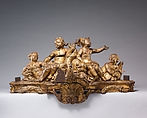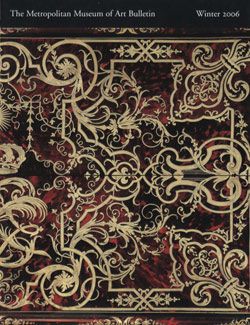Supports for a stretcher from a console table
Not on view
Louis XIV was succeeded in 1715 by his great-grandson Louis XV (1710–1774), then only five years old. During the eight years that Philippe II, due d'Orléans (1674–1723), served as regent (the Régence period), the court moved back to Paris, but in 1723, when the young king came of age, Versailles once again became the main royal residence. Two years later Louis XV married Marie Leszczynska (1703–1768), daughter of Stanislas I of Poland (r. 1704–9 and 1733–36), and she was given the quarters in the palace that had belonged to the queen consort of Louis XIV, Marie Thérèse (1638–1683). As part of the renovation of the queen's bed chamber after the birth of the dauphin in September 1729, a new pier glass and matching console table were made for the room by sculptors Jules Degoullons, Mathieu Legoupil (active 1714-35), and Jacques Verberckt (1704–1771) following Robert de Cotte's designs. The mirror, incorporating a portrait of the queen's father and surmounted by the Polish crown, is still in the room today. The matching table was removed in 1786 when the bedchamber was refurbished for Marie Antoinette. In a detailed memorandum of 1730 the sculptors described their work with such precision that French scholar Pierre Verlet was able to establish that a fragment in the Museum's collection formed part of the table's stretcher, the only element that appears to have survived. A drawing made about 1735 showing the elevation of the window wall in the queen's bedroom includes the mirror and the outline of the table. The unusually wide table was supported on three cabriolet legs. Part of the center leg is still visible on the plinth, and tenons on either end indicate where the other two legs were originally attached. The rich carved decoration of foliage, palm leaves, and floral garlands complemented the ornamentation on the mirror above. For the carved elements the artists charged 850 livres, 350 livres of which was for the figurai composition, a group of four children and two entwined dolphins that clearly referred to the recent birth of the dauphin. Standing near this table or even leaning against it, Marie Leszczynska held audiences with her subjects.
This image cannot be enlarged, viewed at full screen, or downloaded.


